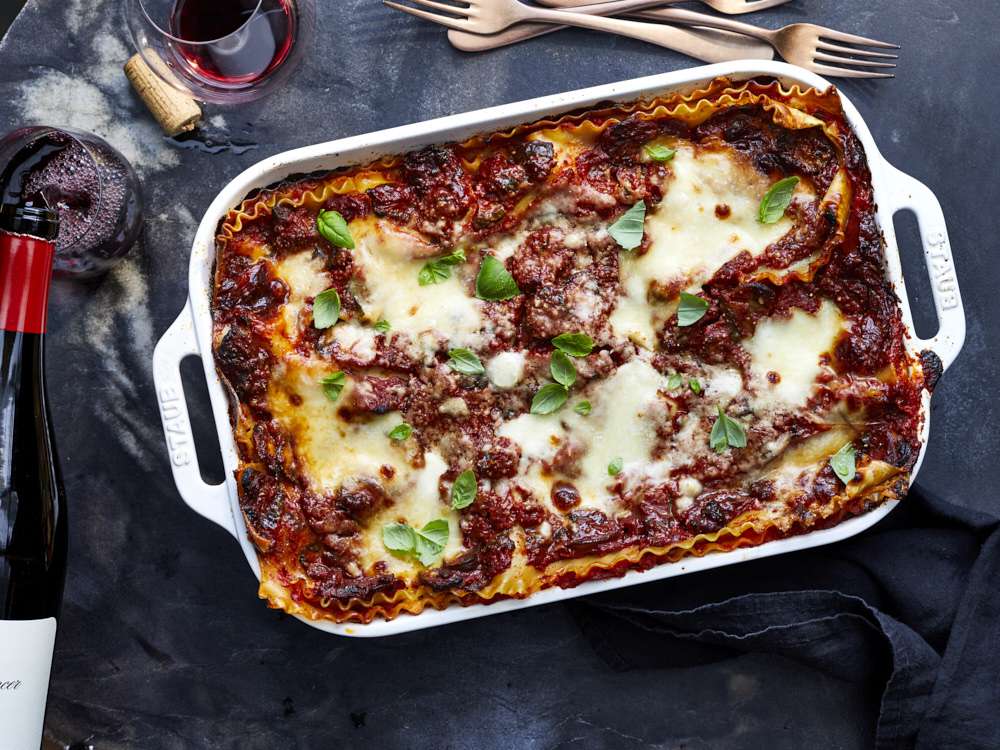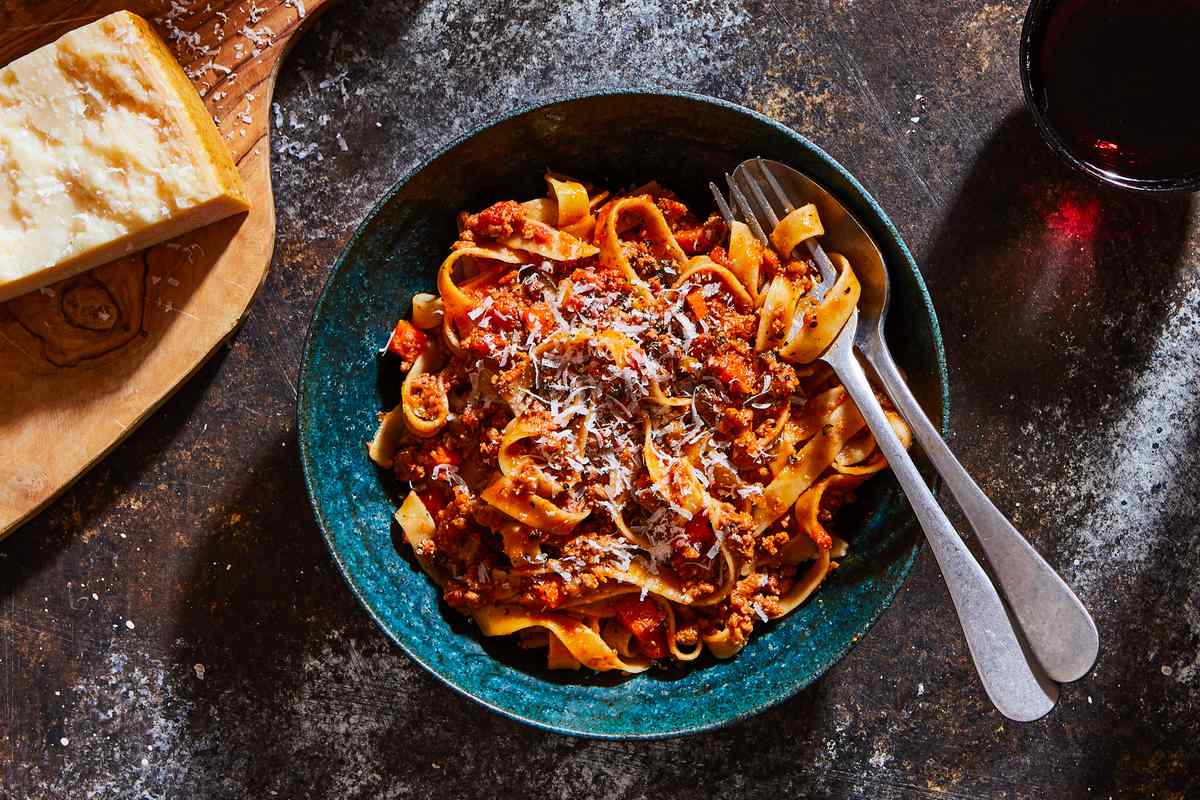Add these quintessential Italian recipes to your cooking arsenal.
There's nothing more satisfying than a big bowl of noodles, and that's why you'll find lots of pasta in this round-up of Italian recipes chefs love. Of course, pasta isn't the only Italian dish worth celebrating—we could never leave out eggplant parmigiana, polpette (meatballs), and a perfectly cooked pot of risotto. Read on for more Italian classics that chefs love to make.

Aprés Ski Lasagna
Victor Protasio
Lasagna
"Lasagna is a dish that brings many of the ingredients of Emilia Romana together in a simple way. Amazing dairy products, cheese, grain (in the form of pasta), and meat. Simply layer pasta sheets with bolognese, bechamel, fresh grated Parmigiano-Reggiano, repeat, repeat, repeat, repeat. Cook, then let it rest. We very lightly gratinate the top layer to get a crispy crust and then garnish with fresh shaved Parmigiano-Reggiano." — Michele Carter, Executive Chef of Oste in Los Angele
Bolognese
"It's a great one-pot pasta sauce and stores well if you want to make a large batch. The key is to sweat out the vegetables and aromatics for almost an hour before browning the meat; too many times people want to rush it. We make 50-pound batches here at Indaco, where the pots are on the stove from 8 a.m. to almost 5 p.m. NEVER RUSH IT. It's Italian; you're supposed to take your time and enjoy some wine." — Mark Bolchoz, Executive Chef at Indaco in Charleston, SCaaaaaaaaaaaaaaaaaaaaaaaa

Marcella Hazan Bolognese Meat Sauce Recipe
Photo and Styling by Julia Gartland
Cacio e Pepe
"Cacio e pepe (literally translates to "cheese and pepper") is one of the classic Roman osteria pastas. Historically, it was pervasive throughout the Roman countryside, and eventually it spread to the rest of the country because of how readily available the components were to the local peasants and shepherds (sheep's milk cheese, pepper, pasta). We make fresh extruded pasta (spaghetti) using semolina, eggs, and water. The pasta is cooked in rapidly boiling salted water until about 90 percent cooked through. The pasta is transferred to pan and tossed with a blend of pasta water (this is key), fresh grated pecorino Romano and toasted (important) fresh cracked black pepper while it finishes cooking. It's important to finish the last little bit of cooking the pasta in the sauce in order for the pasta to 'drink up the sauce' as it continues to rehydrate during the last stages of cooking. The pasta is garnished with a little more fresh cracked pepper, shaved pecorino Romano, and something not commonly seen in most cacio but that we do: fresh lemon zest." — Michele Carter
"The dish I often recommend that home cooks take a stab at is cacio e pepe—it's a classic. And, with some practice, once you have the technique down, it's an easy dish to make it seem like you're a pro. Also, the ingredients are usually on hand so when you whip it up last minute, your guests will think you're a natural. " — Brandon Boudet, Executive Chef and Co-owner of Little Dom's + Little Dom's Seafood
"Most think that cacio e pepe simple to make because of the minimal amount of ingredients, but it is really the dish that takes the most skill and technique to execute properly because it has nothing to hide behind. If you master it, you are ready to take on any Italian recipe. Common mistakes to look out for include adding too much cracked pepper, not emulsifying the pecorino cheese at the right time or for long enough, and not using the right amount of extra virgin olive oil and butter. It takes practice, but if you cook this dish enough, you can make it live up to its hype and impress your guests every time." — Frank Pullara, chef and owner of Culaccino in Franklin, TN

Three Pepper Cacio e Pepe
Victor Protasio
Perfectly Cooked Dry Pasta
"One quintessential Italian dish every home cook should learn to master is perfectly cooked pasta. I see a lot of people approaching pasta the wrong way and it's an easy fix if you know how to do it correctly. The first step is the pasta itself. When buying dry pasta, I recommend a bronze extruded pasta, which is something just about everyone can find in their local grocery store. The reason for this is the pasta is extruded through bronze dies as opposed to Teflon, and it leaves little textured tears in the pasta that help the sauce cling to it. The next step is to cook the pasta about 2 to 3 minutes less than it says on the package instructions. When straining it, set aside some of that great, starchy pasta water (about two cups per pound of pasta), and put the strained pasta back in the pan with the pasta water and the sauce to cook those last 2 to 3 minutes. This crucial step in the process allows the sauce to glaze the noodles completely and will change the home chef's pasta game forever!" – Brian Lockwood, Consulting Chef at Benzina (Denver, CO)
Panzanella
"It seems like an easy dish, but can be disappointing and soggy if not balanced. Proper texture and flavor starts with a juicy ripe tomato, a toasted or dry bread cube, cucumber, fruity olive oil balanced with white wine vinegar, beautiful basil, thin onion and sweet olive." — Amy Brandwein, the chef owner of Centrolina and Piccolina (Washington DC)

Tomato, Basil, and Cucumber Panzanella
Victor Protasio This summer blockbuster panzanella from Samin Nosrat, author of Salt, Fat, Acid, Heat, pairs oven-roasted sourdough croutons with juicy ripe tomatoes, raw red onion, and crisp cucumbers.
Fresh Pasta with Mushrooms
"A beautiful pasta dish starts with amazing pasta. An essential skill any Italian chef or cook should master. The ratio of flour to whole eggs/semolina/egg yolks is extremely important so it has silky chew but a bite. How to cook mushrooms is so misunderstood and many are not cooked enough to bring out caramelization. The final notes of herbaceousness, olive oil, and butter and a dash of Parmigiano-Reggiano makes a simple dish special." — Amy Brandwein
Meatballs
"I think everyone should have a solid meatball recipe. Who doesn't love a good meatball? Mine has lots of breadcrumbs, Parmesan, roasted garlic, and parsley. There's no set definition on what has to be in a meatball, so it's the perfect dish to really make your own." — Victor King, Executive Chef at The Essential in Birmingham, AL

Sicilian-Style Meatballs
© Andrew Purcell
Ricotta Gnudi
"Home cooks should know how to make ricotta gnudi, a nude pasta not wrapped in dough, but rather made with ricotta cheese and semolina. It doesn't require machines and ricotta and tomatoes are two ingredients Italian chefs usually have in the kitchen, at least I do. The tomatoes can make a quick and easy tomato sauce, and you can even use the pulp to make spicy tomato jam, which is delicious with braised short ribs, creamy semolina, or even on paninis." — Chef Barbara Lynch, Barbara Lynch Collective in Boston, MA
Filetto di Pomodoro
"This classic Italian tomato pasta dish has very few ingredients and brings the freshness we all crave when having carbs. It consists of thinly sliced Roma tomatoes, tomato paste, garlic, chili flakes, olive oil and fresh basil. The sauce comes together in ten minutes, and believe me a little parmesan on top and you can't go wrong." — Mario Monte, Executive Chef at Colada Shop

Sauce-Simmered Spaghetti al Pomodoro
© Christina Holmes
Eggplant Parmigiana
"There are many poor examples of eggplant parmigiana, usually with very thick layers and copious amounts of cheese. Many times the eggplant is breaded with flour, eggs, and bread crumbs, and this leads to a heavy dish. A delicious parmigiana starts with thin layers, light cheese and a sweet sauce. Should be digestible and satisfying, hitting all the deep flavor notes." — Amy Brandwein
Risotto
"Cooking risotto is not as simple as it looks; there is a real skill to it. You need to choose the right produce, time it well and take care at each step. You don't want to serve risotto too soft or too al dente." — Antonio Salvatore, Executive Chef at Rampoldi
Linguini Alle Vongole
"In Italy, depending where you live, you will be basically fed with one of these dishes. If you live along the coast, linguine alle vongole will be your go-to dish; if you are in the northern regions of Italy, risotto alla parmigiana will be the traditional dish; and a pasta with a simple tomato sauce and fresh basil is pretty much a staple you will find in on every table in Italy. These dishes are super simple to shop for, easy to cook, and taste delicious." – Chef Theo Schoenegger, Executive Chef of Sinatra at Wynn Las Vegas
This article was written by Maria Yagoda from Food & Wine and was legally licensed through the Industry Dive publisher network. Please direct all licensing questions to legal@industrydive.com.






